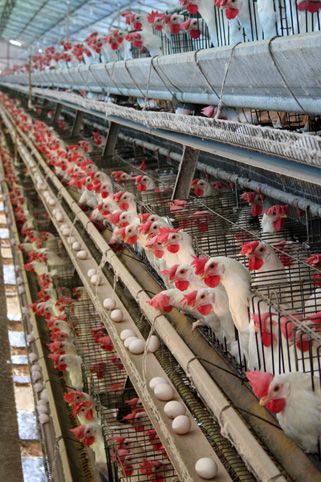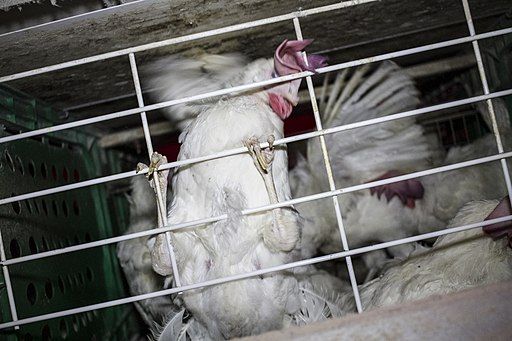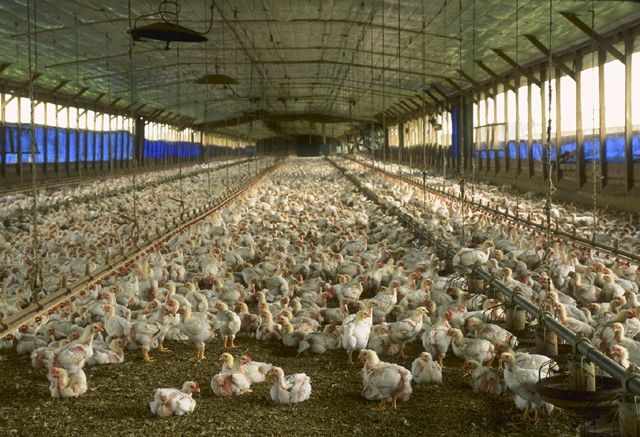In 2016, Walmart announced it was transitioning to cage-free eggs in the U.S., with the goal of only buying eggs from cage-free suppliers by 2025. While this is a step in the right direction, they have a long way to go — especially in other nations around the globe. A new undercover investigation by Mercy for Animals reveals a Walmart egg supplier in Brazil uses cramped cages and leaves hens in deplorable conditions:
“The images are very shocking but the most disturbing part of the investigation is when you realize this is the standard of the industry,” Lucas Alvarenga, MFA’s vice president of Brazil told Lady Freethinker. “There are about 200 million chickens confined in battery cages like that in Brazil and they represent about 95% of the egg consumption in Brazil.”
Egg-laying hens lead a life of suffering in cramped cages
Unfortunately, keeping egg-laying hens in battery cages is the norm — not just in Brazil, but throughout the world. On average, the wire cages measure a measly 18 by 24 inches. That doesn’t even seem like enough space for one bird, but egg producers cram as many as 10 birds into a single cage.
This cruel confinement prevents them from moving around, preening, and having even the most basic comforts. They can’t flap their wings, and many cannot even stand up straight.
“When you realize that this is ‘fine’ for the companies and for the producers, we realize how urgent it is for us to work harder to expose all this cruelty for the people,” Alvarenga said.
The egg industry puts profit above humane treatment

Hens laying eggs in Bastos, São Paulo, Brazil. Picture by Secretaria de Agricultura e Abastecimento do Estado de São Paulo Agriculturasp CC BY 2.0 via Wikimedia Commons
The egg industry wasn’t always this way, but as demand for eggs rose, the desire for efficiency and profit led producers to start caging chickens. In their natural environment, chickens are very social and spend most of the day foraging. When hens lay eggs, they usually stray away to find a secluded place to nest in a protected area.
Putting chickens into small cages forces hens to lay eggs exactly where they are. Some setups actually funnel the eggs to make collection easier. Everything is in one place and easy to manage, which reduces costs. Switching to cage-free requires more expenses. In fact, it usually costs producers 36 percent more to produce cage-free eggs. Clearly, this type of system views hens solely in terms of cost and blatantly ignores the chickens’ suffering.
“When you stop for a second and realize that all these birds spend their entire lives confined in tiny cages like that you have a glimpse of how serious the situation is,” Alvarenga explained. “If we can’t imagine ourselves locked up in a metro full of people in a way that you can barely open your arms, imagine these intelligent and sentient beings in this situation for their entire lives.”
Egg-laying hens suffer many health problems and die young

Picture by Shpernik088 (Own work) CC BY-SA 4.0 via Wikimedia Commons.
It isn’t just about living in a cramped space. Spending their lives in cages takes its toll in other ways, too. The birds often develop problems with their feathers because they can’t preen, feet problems from the hard wires, and osteoporosis from forced over-production of eggs.
Finally, once hens slow their egg production (at about 72 weeks, or roughly a year and a half), they’re sent to a slaughterhouse. In a more natural environment, chickens can live five years or even longer.
If they knew how chickens lived, many people would eat differently
Many people don’t fully understand the tortured lives of hens. That’s why investigations like this are so important. Polls show people don’t realize how poorly chickens are treated, but if they did, they might make different choices.
Cage-free and free-range eggs aren’t much better

Cage-free and Free-range eggs don’t guarantee chickens a good life. Picture by Larry Rana (USDA) CC0, via Wikimedia Commons.
Unfortunately, simply choosing “cage-free” and “free-range” eggs isn’t a much better option. While these labels do mean that the birds aren’t kept in battery cages, they don’t really describe the complicated conditions the hens live in.
Cage-free hens can move around, but remain inside and have nesting boxes while free-range hens can move around, inside and out. However, according to the Washington Post these chickens still have limited space. Cage-free hens usually have 1 to 1.5 square feet per bird while free-range hens have 2 square feet per bird and sometimes more.
The environment they live in can vary widely, and is usually dirty, muddy — and still, often cramped. They may fight each other in the small spaces, suffer injuries no one will treat, and commonly contract diseases.
When it comes down to it, large scale industries focused on profit rather than humane conditions will never treat the animals well.
Plant-based diets are the only sure way to stop animal suffering
“Choosing plant-based meals is the best way to help animals and to avoid unnecessary suffering,” Alvarenga advised. “But if you are not satisfied only by ditching animal products, you can definitely help by spreading these investigation videos and helping the animals to have a voice.”
Aside from sharing MFA’s videos, you can also sign their petition to stop Walmart from using these poor hens.
“They desperately need our help. People have the right to know what is going on behind these walls that hide tremendous suffering in the world,” Alvarenga said, adding that “If we truly want to live in a more peaceful planet, we must understand the urgency of making more compassionate choices.”

